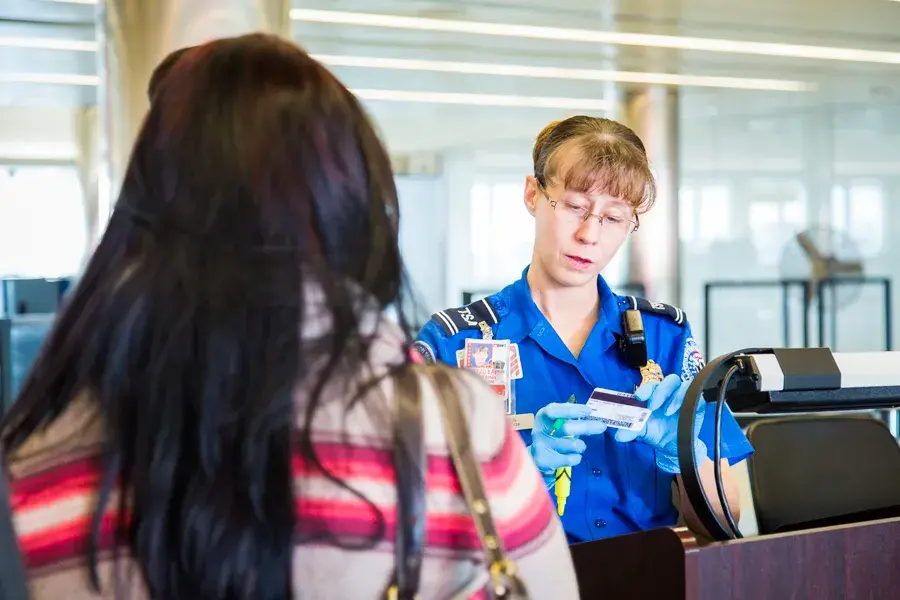The free movement of people and goods is key to our prosperity and to freedom itself. Explore how DHS personnel safeguard the nation’s transportation networks and the individuals using them.
Not to Glaze Over TSA’s Unique Set of Skills 
It’s well known that gels and liquids are allowed in one’s airplane carry-on baggage, so long as they are in containers smaller than 3.4 ounces. It’s a necessary precaution since certain chemicals and other gel-like substances in greater quantities could pose a danger to flights. Despite being relatively benign (if you ignore sugar content), gelatin deserts and puddings must also comply with this rule. However, in June 2015, a different type of foodstuff became a mortal threat at John F. Kennedy International Airport (JFK) in New York, and it nearly proved fatal: doughnuts.
It was just another day for one Transportation Security Officer working a security checkpoint at JFK’s Terminal 1. That is, until the crowd of passengers awaiting screening suddenly erupted into commotion.
As the officer approached the source of the unfolding panic, he discovered that a woman in the middle of the checkpoint line had collapsed into a fit of violent choking. The officer instinctively sprang into action, using the Heimlich maneuver in an attempt to dislodge the obstruction from her throat. To no avail.
Within seconds the woman stopped breathing and her body went limp. Deprived of oxygen, she began to turn blue. The woman’s husband told the officer that his wife had been eating a doughnut, which got stuck in her throat. The situation looked grimmer with each passing second.
With outbound onlookers abound and refusing to give up, this intrepid TSA officer lowered the lifeless woman to the floor and began performing CPR. She had no pulse. He continued chest compressions anyway. The officer instructed the husband to pinch his wife’s nose and breathe into her mouth. More chest compressions. Another TSA officer called 911 and the Port Authority Police.
Five excruciatingly long minutes went by: chest compressions; breath; chest compressions; breath. At long last, a cough! Then, she started to breathe again on her own, and mercifully regained consciousness.
“I monitored her and she began to breathe on her own as the color came back to her face,” said Davis, a Suffolk County resident who has worked for TSA since 2005. As the woman regained consciousness, Davis wanted to check her alertness level. He asked her what type of doughnut she had been eating. She dutifully recalled every minute detail of it—of course she had; she’s unlikely to ever forget this clogging confection.
This story’s happy ending is a testament to TSO Davis’ character and determination, as well as the TSA ethos. TSA is responsible for ensuring the safety of the Nation’s transportation systems, and its passengers from whatever may seek to harm them—from daggers to, in this case, doughnuts.
At TSA, transportation security is fulfilled one passenger at a time, 2 million times a day.
DHS Component Involved
“Open Samsonite!” 
Usually when responding to a checked baggage alarm, Transportation Security Officers expect to find something that is, indeed, cause for alarm. Canisters of a potentially dangerous substance, say, concealed within layers of clothing or embedded within electronics. But on one such occasion at New York’s LaGuardia Airport, a TSO was shocked to discover what appeared on the X-ray screen to be a small dog!
The dog, a Chihuahua, had apparently climbed into its owner’s suitcase as she was packing for her trip. Without realizing it was there, she zipped up her luggage and left for LaGuardia.
TSA screens every piece of checked luggage—and thankfully so, for this dog. Upon its discovery, TSA worked with the airline to identify the owner. They managed get into contact with her before her flight had taken off, and arranged for her husband to pickup their little stowaway.
Other cases of possessions lost at TSA checkpoints—perhaps not pets, but equally as precious to their owners—are common. By now, most air travelers are familiar with the plexiglass case that stands near the start of many security lines. Filled with letter openers and the occasional replica Klingon dagger from San Diego Comic Con, this shrine of sharp objects acts as a display informing passengers “what not to bring."
There’s an argument to be made that there should be another for “what not to leave behind.” However, thanks to the dedication of TSOs with a veritable detective streak, most misplaced valuable items make it back to their rightful owners.
One such item was a gold Cartier watch left behind by its owner at the Newark Liberty International Airport security checkpoint. Encrusted with diamonds, the value of the watch was in the neighborhood of $100,000!
A TSA officer spotted the watch, recorded it with other items left behind by passengers that day, and turned it into the TSA lost and found location at the airport.
Unfortunately, the owner, a real estate entrepreneur, didn’t realize his watch was missing until he had already landed back in his native Japan. TSA worked with a New York-based business associate of the owner to track down the watch and have it returned. Though, not before verifying its ownership. TSA officers compared photos supplied by the owner of him wearing the watch, with the watch in their possession to ensure they were indeed handing this treasure back to its proper owner.
“We’re always glad when we can help reunite passengers with their lost belongings, regardless of the value of the item,” said TSA Federal Security Director Thomas Carter.
